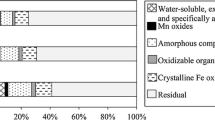Abstract
The Lysina catchment in the Czech Republic was studied to investigate the biogeochemical response of Al to high loadings of acidic deposition. The catchment supports Norway spruce plantations and is underlain by granite and podzolic soil. Atmospheric deposition to the site was characterized by high H+ and SO4 2− fluxes in throughfall. The volume-weighted average concentration of total Al (Alt) was 28 μmol L−1 in the O horizon soil solution. About 50% of Alt in the O horizon was in the form of potentially-toxic inorganic monomeric Al (Ali). In the E horizon, Alt increased to 71 μmol L−1, and Ali comprised 80% of Alt. The concentration of Alt (120 μmol L−1) and the fraction of Ali (85%) increased in the lower mineral soil due to increases in Ali and decreases in organic monomeric Al (Alo). Shallow ground water was less acidic and had lower Alt concentration (29 μmol L−1). The volume-weighted average concentration of Alt was extremely high in stream water (60 μmol L−1) with Ali accounting for about 60% of Alt. The major species of Ali in stream water were fluorocomplexes (Al-F) and aquo Al3+. Soil solutions in the root zone were undersaturated with respect to all Al-bearing mineral phases. However, stream water exhibited Ali concentrations close to solubility with jurbanite. Acidic waters and elevated Al concentrations reflected the limited supply of basic cations on the soil exchange complex and slow weathering, which was unable to neutralize atmospheric inputs of strong acids.
Similar content being viewed by others
References
Buzek, F., J. Hruška, and P. Krám: 1995, “Three-component Model of Runoff Generation, Lysina Catchment, Czech Republic”, Water, Air, and Soil Pollution, 79, 391–408.
Cappo, K.A., L.J. Blume, G.A. Raab, J.K. Bartz, and J.L. Engels: 1987, “Analytical Methods Manual for the Direct/Delayed Response Project Soil Survey”, US Environmental Protection Agency, Las Vegas, Nevada.
Černý, J., 1993 “Atmospheric Deposition in the Krušné Hory Mts. Preliminary Results of Throughfall Measurements”, Acta Universitatis Carolinae Geologica, Prague, 37, 29–44.
Cronan, C.S., R. April, R.J. Barlett, P.R. Bloom., C.T. Driscoll, S.A. Gherini, G.S. Henderson, J.D. Joslin, J.M.A. Kelly, R.M. Newton, R.A. Parnell, H.H. Patterson, D.J. Raynal, M. Schaedle, C.L. Schofield, E.I. Sucoff, H.B. Tepper, and F.C. Thornton, 1989: “Aluminum Toxicity in Forests Exposed to Acidic Deposition: The ALB1OS Results”, Water, Air, and Soil Pollution, 48, 181–192.
Driscoll, C.T., and W.D. Schecher, 1990: “The Chemistry of Aluminum in the Environment”, Environmental Geochemistry and Health, 12, 28–49.
Hruška, J., and P. Krám, 1994a: “Hydrogeochemical Monitoring of a Forested Catchment with Extremely High Aluminium Concentrations in Runoff: the Lysina Catchment, Czech Republic”, International Association of Hydrological Sciences Publication 219, 357–368.
Hruška, J., and P. Krám, 1994b: “Aluminium Chemistry of the Root Zone of Forest Soil Affected by Acid Deposition at the Lysina Catchment, Czech Republic”, Ecological Engineering, 3, 5–16.
Huntington, T.G., D.F. Ryan, and S.P. Hamburg, 1988: “Estimating Soil Nitrogen and Carbon Pools in a Northern Hardwood Forest Ecosystem,” Soil Science Society of America Journal, 52, 1162–1167.
Krám, P., and J. Hruška, 1994: “Influence of Bedrock Geology on Elemental Fluxes in Two Forested Catchments Affected by High Acid Deposition”, Applied Hydrogeology, 2, 50–58.
McAvoy, D.C., R.C. Santore, J.D. Shosa, and C.T. Driscoll, 1992: “Comparison between Pyrocatechol Violet and 8-hydroxyquinoline Procedures for Determining Aluminum Fractions”, Soil Science Society of America Journal, 56, 449–455.
Paćes, T., 1985: “Sources of Acidification in Central Europe Estimated from Elemental Budgets in Small Basins”, Nature, 315, 31–36.
Schecher, W.D., and C.T. Driscoll, 1995: “ALCHEMI: A Chemical Equilibrium Model to Asses the Acid-Base Chemistry and Speciation of Aluminum in Dilute Solutions”, in R.H. Loeppert, A.P. Schwab and S. Goldberg (eds.) Chemical Equilibrium and Reaction Models, Soil Science Society of America Special Publication 42, 325–356.
Walker, W.J., C.S. Cronan, and P.R. Bloom, 1990: “Aluminum Solubility in Organic Soil Horizons from Northern and Southern Forested Watersheds”, Soil Science Society of America Journal., 54, 369–374.
Author information
Authors and Affiliations
Rights and permissions
About this article
Cite this article
Krám, P., Hruška, J., Driscoll, C.T. et al. Biogeochemistry of aluminum in a forest catchment in the Czech Republic impacted by atmospheric inputs of strong acids. Water Air Soil Pollut 85, 1831–1836 (1995). https://doi.org/10.1007/BF00477246
Issue Date:
DOI: https://doi.org/10.1007/BF00477246




